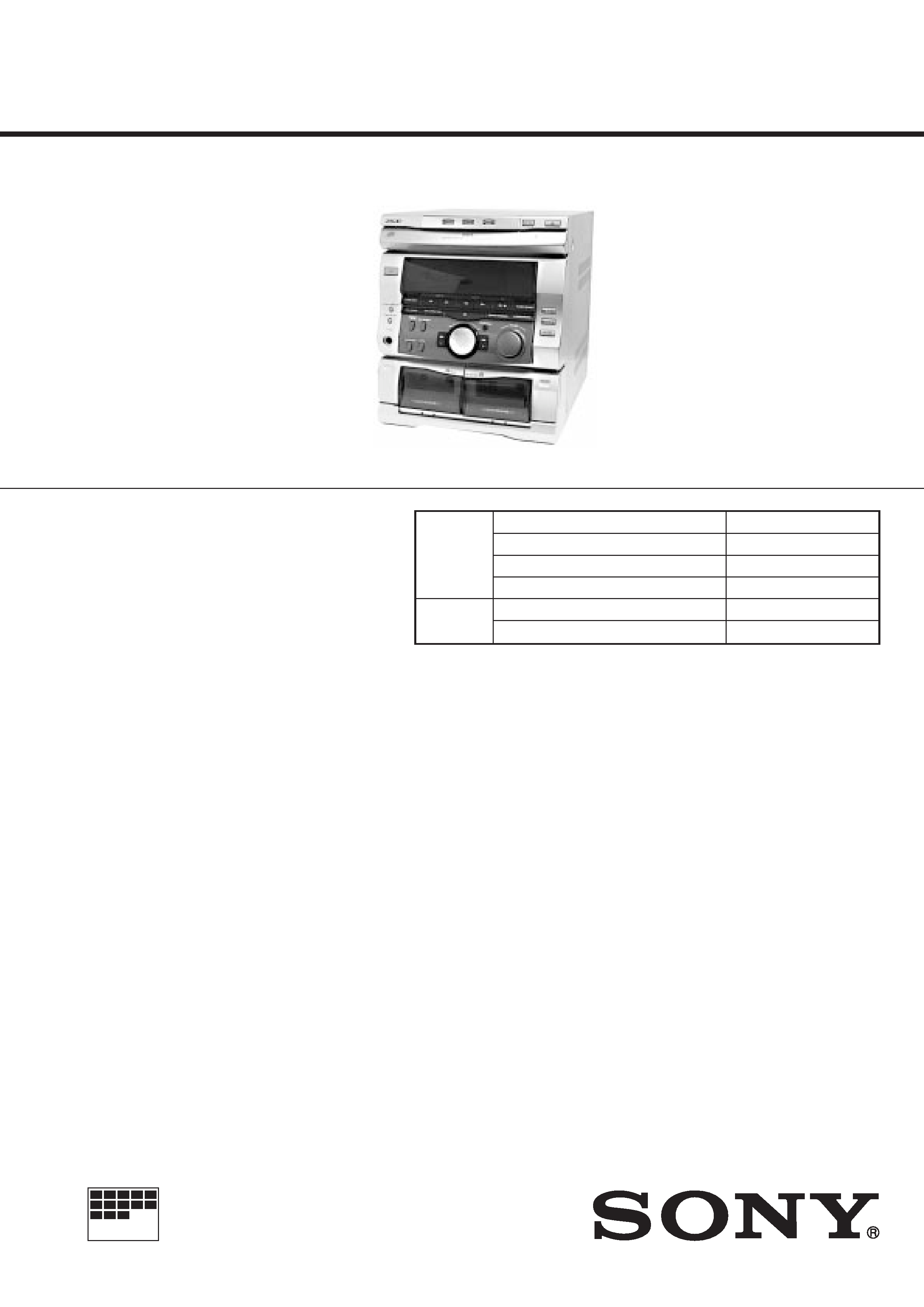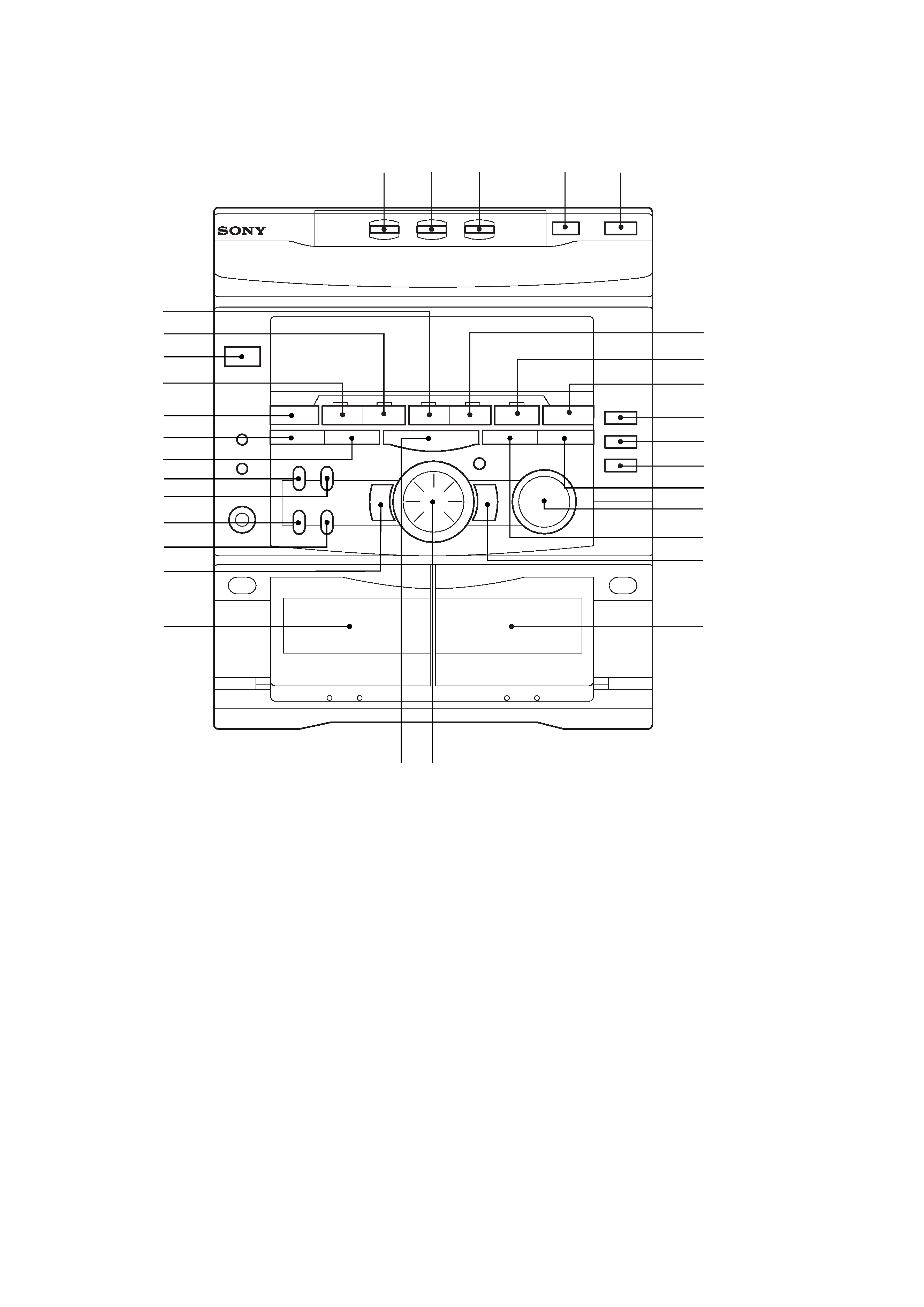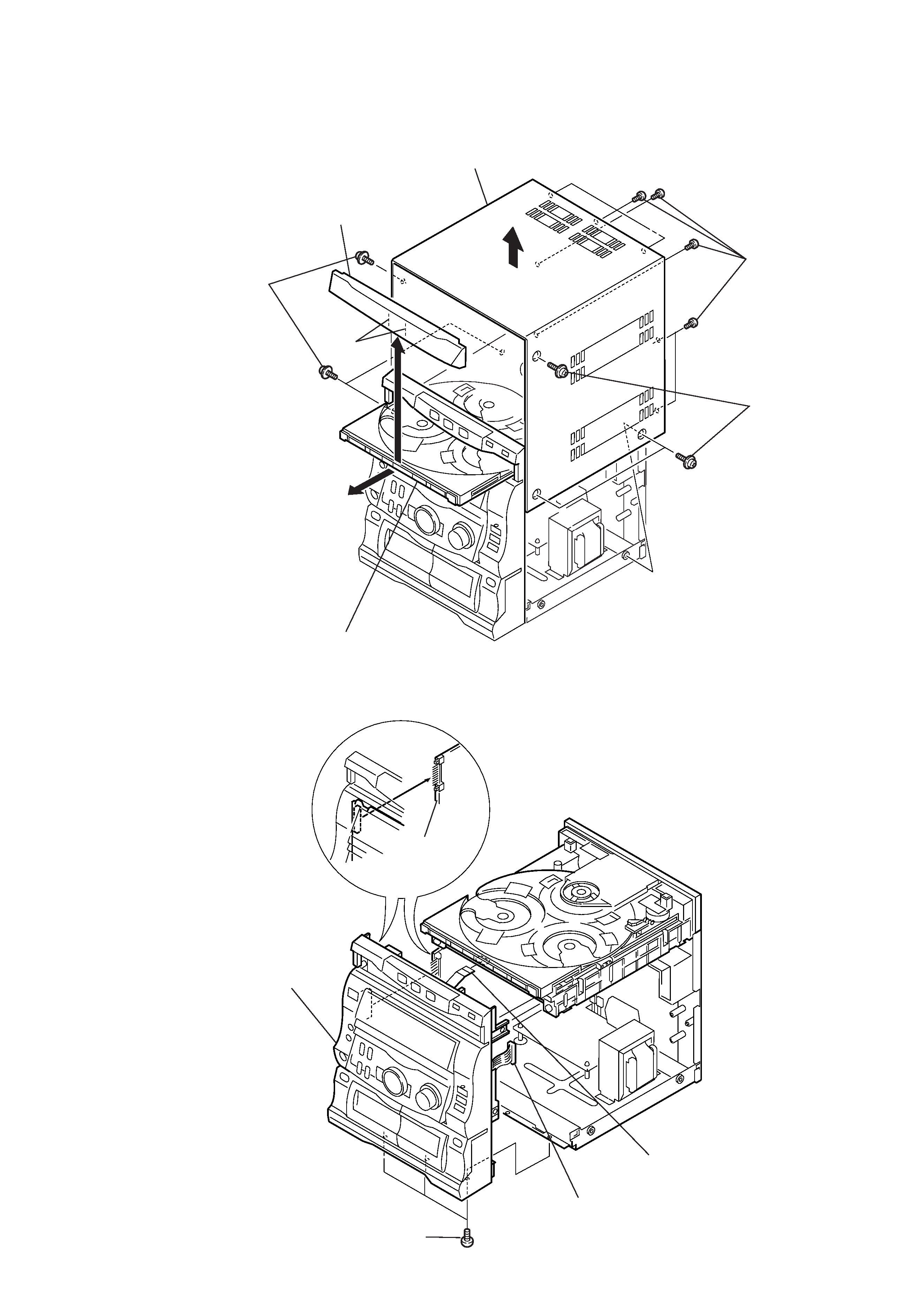
HCD-R500/RX55
AEP Model
UK Model
SERVICE MANUAL
MINI Hi-Fi COMPONENT SYSTEM
MICROFILM
HCD-R500/RX55 is the tuner, deck, CD and
amplifier section in MHC-R500/RX55.
SPECIFICATIONS
Model Name Using Similar Mechanism
HCD-G101
CD Mechanism Type
CX3
Base Unit Type
KSM-213BCM
Optical Pick-up Type
KSS-213B/S-N
Model Name Using Similar Mechanism
NEW
CWB44RR10
CD
SECTION
TAPE DECK
SECTION
Tape Transpor Mechanism Type
Amplifier section
North American model
Continuous RMS power output
50 W + 50 W (6
at 1 kHz, 10% THD)
Other models
The following measured at AC 110, 220 V 60 Hz;
DIN power output (Rated) 35 W + 35 W (6
at 1 kHz, DIN)
Continuous RMS power output (Reference)
45 W + 45W (6
at 1 kHz, 10% THD)
The following measured at AC 120, 240 V 60 Hz;
DIN power output (Rated) 40 W + 40 W (6
at 1 kHz, DIN)
Continuous RMS power output (Reference)
50 W + 50W (6
at 1 kHz, 10% THD)
Peak music power output (Reference)
600 W
Inputs
MD IN (phone jacks) : voltage 450 mV, impedance 47 k
Outputs
MD OUT (phone jacks) :
voltage 250 mV, impedance 1 k
PHONES (stereo phone jack) :
accepts headphones of 8
or more
SPEAKER :
accepts impedance of 6 to 16
CD player section
System
Compact disc and digital audio system
Laser
Semiconductor laser (
= 780 nm)
Emission duration: continuous
Laser output
Max. 44.6 µW*
*This output is the value measured at a
distance of 200 mm from the objective
lens surface on the Optical Pick-up Block
with 7 mm aperture.
Frequency response
20 Hz 20 kHz (± 0.5 dB)
Wavelength
780 790 nm
DIGITAL OUT (OPTICAL)
(Square optical connector jack, rear panel)
Wavelength
600 nm
Output Level
18 dBm
Tape deck section
Recording system
4 -track 2 -channel stereo
Frequency response
40 13,000 Hz (± 3dB), using Sony
TYPE
cassette
Tuner section
FM stereo, FM/AM superheterodyne tuner
Photo : HCD-RX55
-- Continued on next page --

CAUTION
Use of controls or adjustments or performance of procedures
other than those specified herein may result in hazardous
radiation exposure.
Notes on chip component replacement
· Never reuse a disconnected chip component.
· Notice that the minus side of a tantalum capacitor may be
damaged by heat.
Flexible Circuit Board Repairing
· Keep the temperature of soldering iron around 270°C
during repairing.
· Do not touch the soldering iron on the same conductor of the
circuit board (within 3 times).
· Be careful not to apply force on the conductor when soldering
or unsoldering.
Laser component in this product is capable of emitting radiation
exceeding the limit for Class 1.
This appliance is classified as
a CLASS 1 LASER product.
The
CLASS
1
LASER
PRODUCT MARKING is
located on the rear exterior.
This caution
label is located
inside the unit.
SERVICING NOTE
NOTES ON HANDLINGTHE OPTICAL PICK-UP BLOCK
OR BASE UNIT
The laser diode in the optical pick-up block may suffer electrostatic
break-down because of the potential difference generated by the
charged electrostatic load, etc. on clothing and the human body.
During repair, pay attention to electrostatic break-down and also
use the procedure in the printed matter which is included in the
repair parts.
The flexible board is easily damaged and should be handled with
care.
NOTES ON LASER DIODE EMISSION CHECK
The laser beam on this model is concentrated so as to be focused on
the disc reflective surface by the objective lens in the optical pick-
up block. Therefore, when checking the laser diode emission,
observe from more than 30 cm away from the objective lens.
SAFETY-RELATED COMPONENT WARNING!!
COMPONENTS IDENTIFIED BY MARK ! OR DOTTED LINE WITH
MARK ! ON THE SCHEMATIC DIAGRAMS AND IN THE PARTS
LIST ARE CRITICAL TO SAFE OPERATION. REPLACE THESE
COMPONENTS WITH SONY PARTS WHOSE PART NUMBERS
APPEAR AS SHOWN IN THIS MANUAL OR IN SUPPLEMENTS
PUBLISHED BY SONY.
FM tuner section
Tuning range
87.5 108.0 MHz
Antenna
FM lead antenna
Antenna terminals
75
unbalanced
Intermediate frequency
10.7MHz
AM tuner section
Tuning range
European model:
MW:
531-1,602 kHz
(with MW tuning interval
set at 9 kHz)
LW:
153-279 kHz
(with LW tuning interval
set at 3 kHz)
Other models:
AM:
531-1,602 kHz
(with AM tuning interval
set at 9 kHz)
530-1,710 kHz
(with AM tuning interval
set at 10 kHz)
Antenna
AM loop antenna
Antenna terminals
External antenna terminal
Intermediate frequency
450 kHz
General
Power requirements
North American model:120 V AC, 60 Hz
Mexican model:
120 V AC, 50/60 Hz
Australian and South African models:
220 240 V AC, 50/60 Hz
Other models:
110 120 V or 220 240 V AC,
50/60 Hz (adjustable with voltage selector)
Power consumption
100 W
Dimensions (w/h/d) incl. projecting parts and controls
Approx. 280
× 320 × 400 mm
(11 1/8
× 12 5/8 × 15 3/4 in)
Mass
Approx. 9.5 kg (20 lb 15 oz.)
Supplied accessories:
AM loop antenna (1)
Remote (1)
RM-SG7 (for HCD-RX55)
RM-SG7B (for HCD-R500)
FM lead antenna (1)
Design and specifications are subject to change without notice.
-- 2 --

TABLE OF CONTENTS
1. GENERAL .......................................................................... 4
2. DISASSEMBLY
2-1.
Upper Cover and CD Door ................................................. 5
2-2.
Front Panel ......................................................................... 5
2-3.
Main Board ......................................................................... 6
2-4.
Amp Board ......................................................................... 6
2-5.
CD Tray .............................................................................. 7
2-6.
CD Decoder Board ............................................................. 7
2-7.
Base Unit ............................................................................ 8
2-8.
Cassette Door ..................................................................... 8
3. MECHANICAL ADJUSTMENTS ............................... 9
4. ELECTRICAL ADJUSTMENTS ................................. 9
5. DIAGRAMS
5-1.
Circuit Boards Location ................................................... 14
5-2.
Block Diagrams
· Deck Section ................................................................... 15
· CD Section ...................................................................... 17
5-3.
IC Block Diagrams ........................................................... 19
5-4.
Printed Wiring Board --CD Section -- ........................... 24
5-5.
Schematic Diagram -- CD Section -- ............................. 29
5-6.
Schematic Diagram --Panel Section -- .......................... 33
5-7.
Printed Wiring Board --Panel Section -- ........................ 37
5-8.
Printed Wiring Board -- Deck Section -- ....................... 42
5-9.
Schematic Diagram --Deck Section -- ........................... 47
5-10. Schematic Diagram --Main Section -- ........................... 51
5-11. Printed Wiring Board --Main Section -- ........................ 55
5-12. Printed Wiring Board -- Amp Section -- ........................ 60
5-13. IC Pin Function ................................................................ 65
6. EXPLODED VIEWS
6-1.
Cabinet Section................................................................. 67
6-2.
Front Panel Section .......................................................... 68
6-3.
Cassette Mechanism Deck Section................................... 69
6-4.
CD Mechanism Deck Section 1 ....................................... 70
6-5.
CD Mechanism Deck Section 2 ....................................... 71
6-6.
Base Unit Section (KSM-213BCM)................................. 72
7. ELECTRICAL PARTS LIST ........................................ 73
-- 3 --

-- 4 --
SECTION 1
GENERAL
LOCATION OF PARTS AND CONTROLS
1
DISC 1 button
2
DISC 2 button
3
DISC 3 button
4
DISC SKIP button
5
§ OPEN/CLOSE button
6
· (TAPE B)
7
· (CD) button
8
TUNER/BAND button
9
r REC button
!º
PAUSE button
!¡
CD SYNC button
!TM
STEREO/MONO button
!£
VOLUME
!¢
REPEAT/MEMORY button
!
, + button
!§
DECK B
!¶
JOG DIAL
!·
(STOP) button
!ª
DECK A
@º
º button
@¡
DBFB button
@TM
SURROUND button
@£
FILE SELECT button
@¢
DISPLAY/DEMO button
@
EDIT/DIRECTION button
@§
PLAY MODE button
@¶
FUNCTION
@·
ª (TAPE A) button
@ª
I/u (POWER) button
#º
· (TAPE A) button
#¡
ª (TAPE B) button
9
8
7
6
0
!¡
!TM
!£
!¢
!
!§
23
4
5
@¶
1
@ª
@·
#º
#¡
@§
@
@¢
@£
@TM
!ª
@¡
@º
!¶
!·

-- 5 --
SECTION 2
DISASSEMBLY
2-1. UPPER COVER AND CD DOOR
Note :
Follow the disassembly procedure in the numerical order given.
2-2. FRONT PANEL
1 Three srews
2 Three screws
3 Seven screws
4 Upper cover
5 Pull out the CD tray and remove the
CD door with releasing craws into the
directioin of arrow.
6 CD door
claws
4 Flat type wire
(CN09)
2 Connector
(CN302)
1 Three screws
5 Front panel
3 Flat type wire
(CN09)
